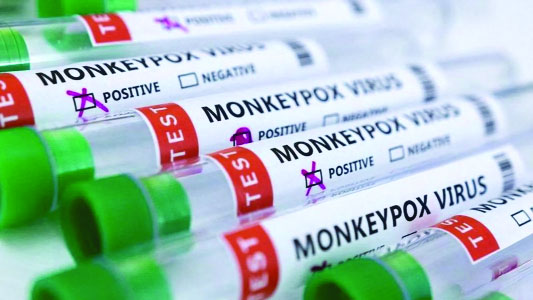Delhi reports first Monkeypox case, India’s fourth
International Desk: Delhi yesterday reported its first case of Monkeypox. With this, the country’s Monkeypox caseload has risen to four. According to official sources, the man (in his 30s) who tested positive has no history of foreign travel.
The infected person had attended a stag party recently in Manali, Himachal Pradesh, they added. He was admitted to the Maulana Azad Medical College Hospital around three days ago after he showed symptoms of Monkeypox.
His samples were sent to the National Institute of Virology (NIV) Pune on Saturday which came out positive, the sources said.
“Contact tracing process has been initiated,” they added. Delhi chief minister Arvind Kejriwal, confirming the case, said that a separate isolation ward has been made at Lok Nayak Jai Prakash Narayan (LNJP) Hospital and there is not need to panic.
The previous three cases were reported from Kerala. While one of the them had returned from UAE, the other two had travelled from Dubai. Monkeypox virus is transmitted from infected animals to humans via indirect or direct contact.
Human-to-human transmission can occur through direct contact with infectious skin or lesions, including face-to-face, skin-to-skin, and respiratory droplets.
India’s first case of Monkeypox, a rare but potentially serious viral illness, was reported from Kollam district of south Kerala on July 14. He is currently undergoing treatment at the Government Medical College Hospital, Thiruvananthapuram. The World Health Organization (WHO) had on Saturday declared Monkeypox as a global public health emergency of international concern.
Expressing concern over rapidly spreading cases of Monkeypox, Dr Poonam Khetrapal Singh, the first Indian elected as regional director of WHO South-East Asia Region, said that with cases concentrated among men who have sex with men, it is possible to curtail further spread of the disease with focused efforts among the at-risk population.
“Monkeypox has been spreading rapidly and to many countries that have not seen it before, which is a matter of great concern. However, with cases concentrated among men who have sex with men, it is possible to curtail further spread of the disease with focused efforts among the at-risk population,” Dr Poonam said in a statement.
Monkeypox virus is transmitted from infected animals to humans via indirect or direct contact. Human-to-human transmission can occur through direct contact with infectious skin or lesions, including face-to-face, skin-to-skin, and respiratory droplets.
History of Monkeypox
A viral infection resembling smallpox and first detected in humans in 1970, Monkeypox is less dangerous and contagious than smallpox, which was eradicated in 1980. Ninety-five percent of cases have been transmitted through sexual activity, according to a study of 528 people in 16 countries published in the New England Journal of Medicine — the largest research to date.
Overall, 98% of infected people were gay or bisexual men, and around a third were known to have visited sex-on-site venues such as sex parties or saunas within the previous month. “This transmission pattern represents both an opportunity to implement targeted public health interventions, and a challenge because in some countries, the communities affected face life-threatening discrimination,” Tedros said earlier, citing concern that stigma and scapegoating could make the outbreak harder to track.
Rare Israeli airstrike in Beirut kills Hezbollah commander and more than a dozen others
International Desk: Israel launched a rare airstrike that killed a senior Hezbollah milita…








